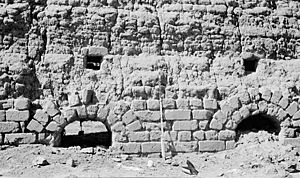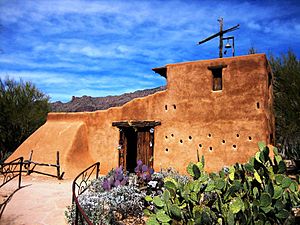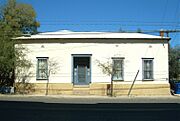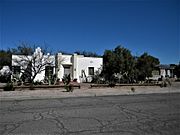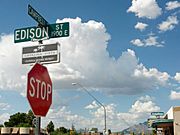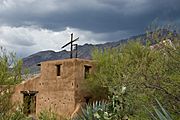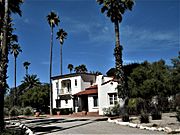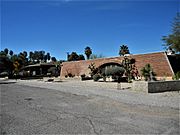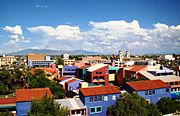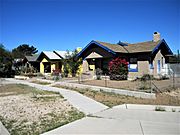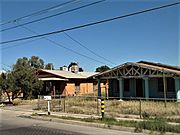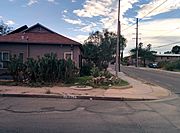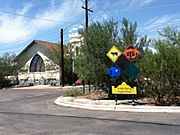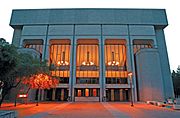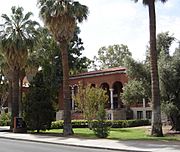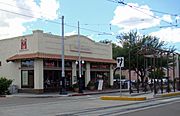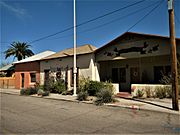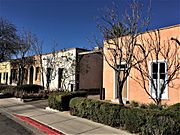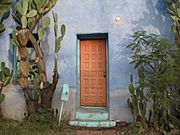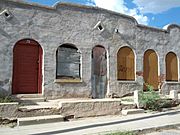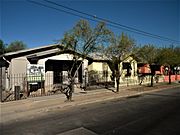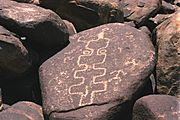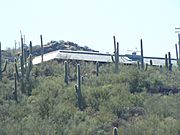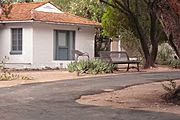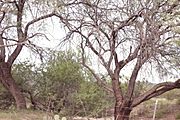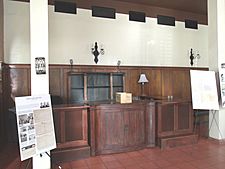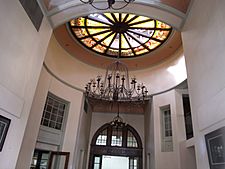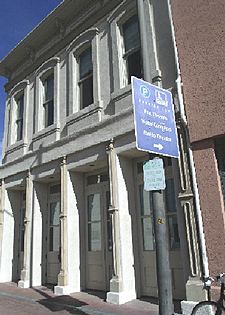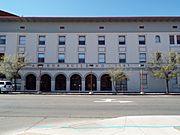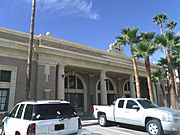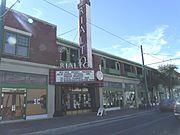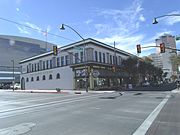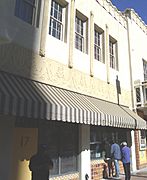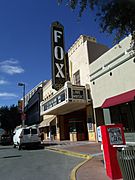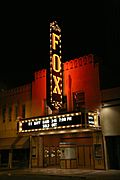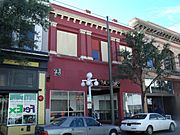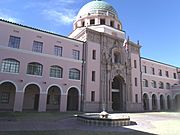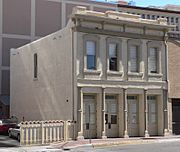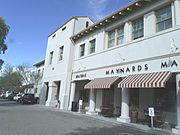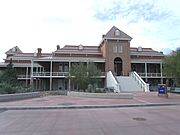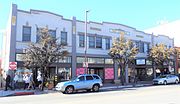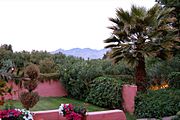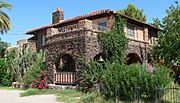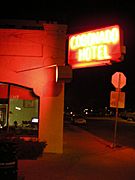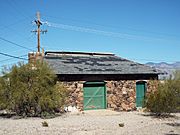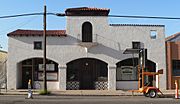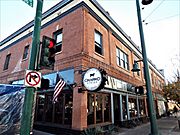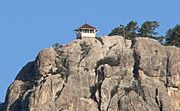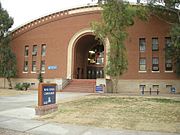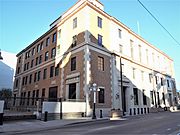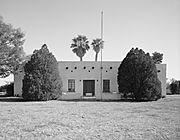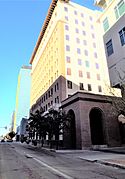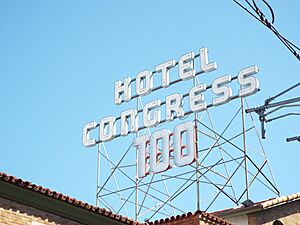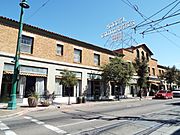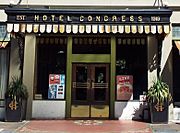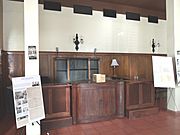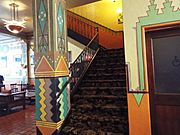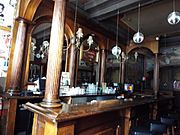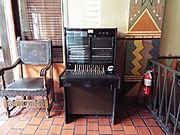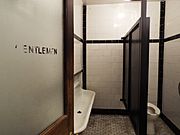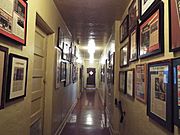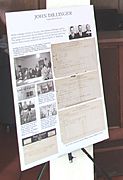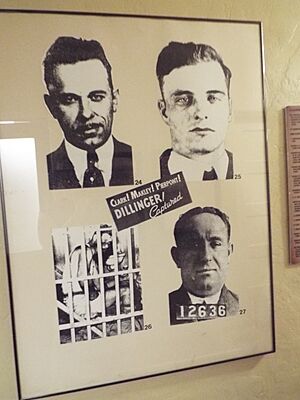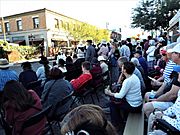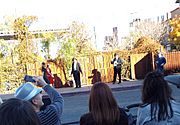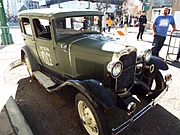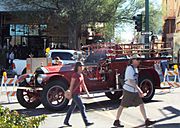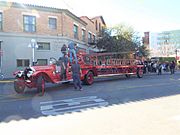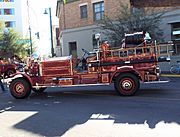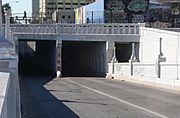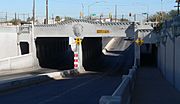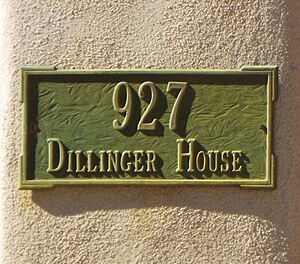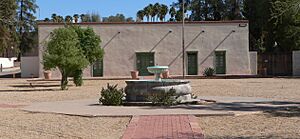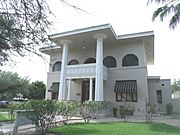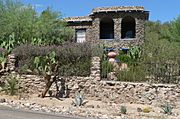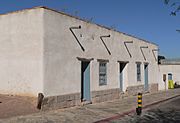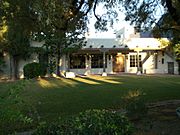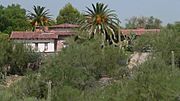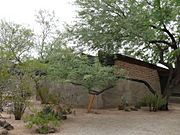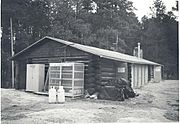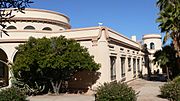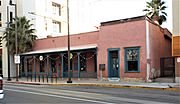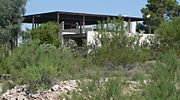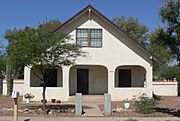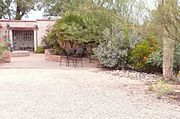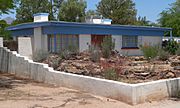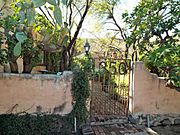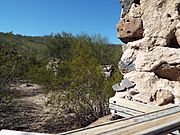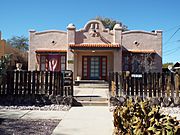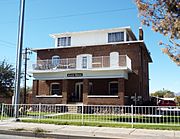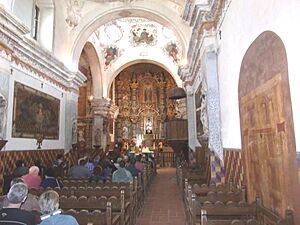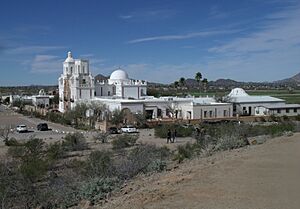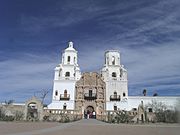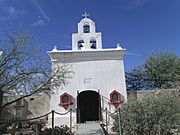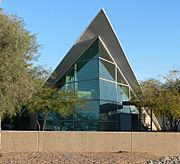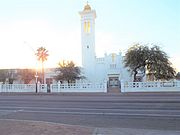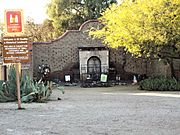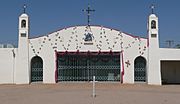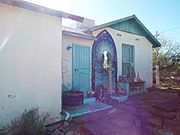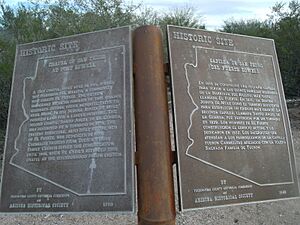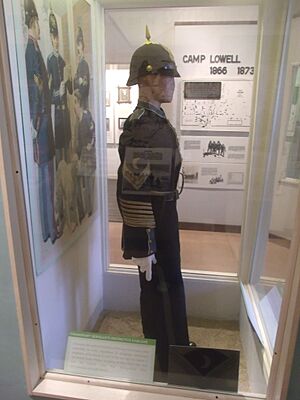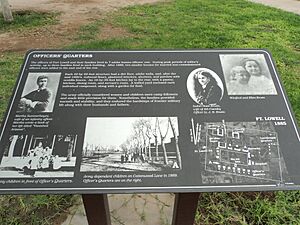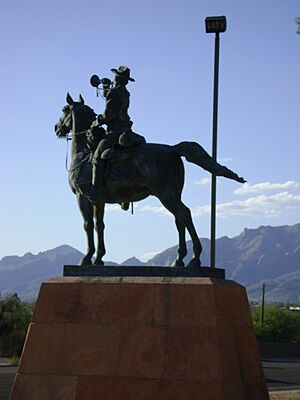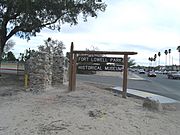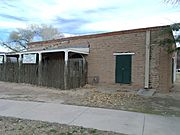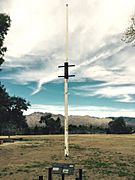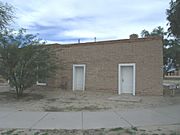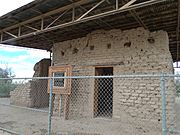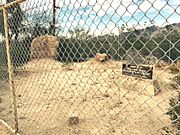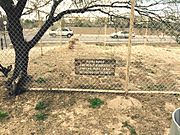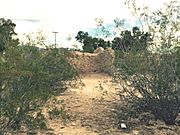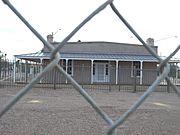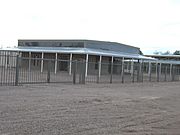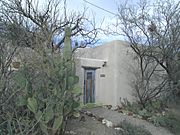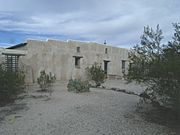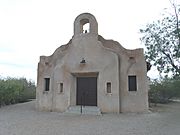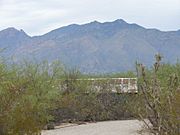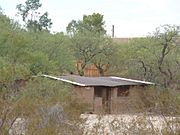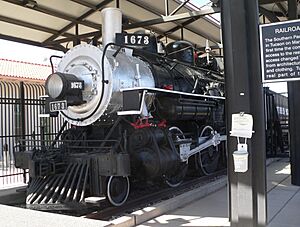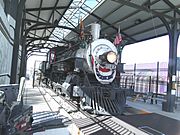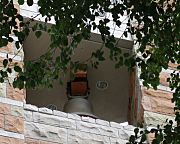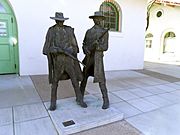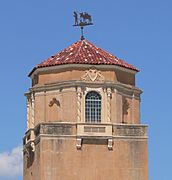List of historic properties in Tucson, Arizona facts for kids
Quick facts for kids
List of historic properties
in Tucson, Arizona |
|
|---|---|
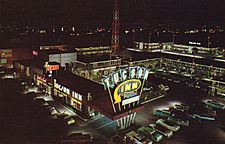
The Tucson Inn, 1956
(Miracle Mile Historic District) |
|
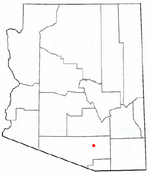
Location in Pima County and the state of Arizona
|
|
| Country | United States |
Tucson, Arizona, is a city with a long and interesting past! This page shares a list of historic places in Tucson. You'll see photos of old buildings, neighborhoods, and other important sites. Tucson is the second-largest city in Arizona, right after Phoenix.
Many of these places are recognized as historic by the National Register of Historic Places. This means they are special because of their history, architecture, or culture. We'll also look at pictures related to Fort Lowell, an old United States Army post that was active from 1873 to 1891.
Contents
Tucson's Story: A Quick Look
People have lived in the Tucson Valley for a very long time. We don't know exactly when the first Native American tribes settled here. But archaeologists have found proof of farming villages along the Santa Cruz River that date back to 1080 BC!
The Hohokam people lived and farmed in the valley between 200 and 1450 AD. Many believe that today's Pima and Tohono O'odham tribes are their descendants. These tribes continued to live in the area for centuries.
In 1540, Francisco Vázquez de Coronado led an expedition through Arizona. He was looking for rumored riches in the "Seven Cities of Cibola." Coronado and his men were the first Europeans to explore the area. However, the "Seven Cities of Cibola" with golden buildings was just a myth.
Later, in 1699, Father Eusebio Francisco Kino arrived. He decided to build a Catholic mission. This mission church, called Mission San Xavier del Bac, wasn't finished until 1797.
Tucson officially became a city in 1775. That's when Hugo Oconór set up the Tucson Presidio, which was like a fort. Oconór was born in Ireland but moved to Spain. He became a military governor in northern Mexico. In 1821, Tucson became part of Mexico when Mexico won its independence from Spain.
In 1854, Tucson became part of the United States. This happened because of the Gadsden Purchase. During the American Civil War, the Confederacy made Tucson their Arizona Territory capital in 1862. But in 1863, the United States created its own Arizona Territory. Tucson served as the territorial capital from 1867 to 1877.
Saving Tucson's History
The Tucson Historic Preservation Foundation started in 1984. Their goal is to save historic places and old neon signs in Tucson. They help get many properties listed on the National Register of Historic Places.
However, this foundation can't stop a historic building from being torn down. If an owner wants to demolish a historic property, they can. For example, the MacArthur Building was built in 1907 as the "Hotel Heide." It was listed as historic in 1983. But after part of it collapsed, it was changed and later removed from the historic list.
Historic Neighborhoods and Areas
Districts and Barrios
A historic district is an area with many old buildings. These buildings are important to a city's culture. "Barrios" is a Spanish word for neighborhoods. Tucson has many historic districts and archaeological districts. The National Register of Historic Places keeps an official list of these important places.
Here are some of the historic districts and barrios you'll see pictured:
- Armory Park Historic Residential District: A neighborhood with many historic homes.
- Blenman-Elm Historic District: Another residential area with a rich past.
- Catalina Vista Historic District: Known for its unique street corners and signs.
- DeGrazia Gallery in the Sun Historic District: This includes artist Ettore DeGrazia's studio and home.
- El Encanto Estates Residential Historic District: A beautiful historic neighborhood.
- El Montevideo Historic District: Features interesting architecture.
- El Presidio Historic District: One of Tucson's oldest neighborhoods.
- Feldman's Historic District: Named after a homesteader and photographer.
- Fourth Avenue Commercial Historic District: A lively area with historic shops.
- Iron Horse Expansion Historic District: An important historic area.
- Marist College Historic District: Includes the old Marist College building.
- Menlo Park Historic District: A collection of historic subdivisions.
- Rillito Race Track Historic District: An old racetrack with a long history.
- Rincon Heights Historic District: A historic residential area.
- John Spring Neighborhood Historic District: Named after a historic figure.
- Tucson Community Center Historic District: An important civic area.
- University of Arizona Campus Historic District: Includes historic buildings on the university campus.
- West University Historic District: A neighborhood near the university.
- Barrio Anita: Originally called McKinley Park.
- Barrio El Hoyo Historic District: A historic neighborhood.
- Barrio El Membrillo Historic District: Features old homes and buildings.
- Barrio Libre: A historic district with a unique character.
- Barrio Santa Rosa: Another historic barrio in Tucson.
- Historic Districts/Barrios
-
Building mural in the Fourth Avenue Commercial Historic District.jpg
Building mural in the Fourth Avenue Commercial Historic District.
-
Building mural in the Iron Horse Expansion Historic District.jpg
Building mural in the Iron Horse Expansion Historic District.
Archaeological Districts
Archaeological districts are areas where scientists have found old remains. These remains tell us about people who lived there long ago.
- The Cocoraque Butte Archaeological District: An important site for studying ancient cultures.
- The Tumamoc Hill Archeological District: A hill with many archaeological findings.
- Archaeological Districts
Other Historic Areas
Tucson has other special historic areas, too.
- Agua Caliente Ranch Rural Historic Landscape: A historic ranch area.
- Deep Well Ranch: A steer ranch with a long history.
- Villa Catalina: Historic apartments.
- Other historic areas
Historic Buildings
Tucson has many old buildings with interesting stories. Here are some of them:
- The MacArthur Building: Built in 1907, it was first called Hotel Heidel. It served passengers from the nearby train station.
- El Paso and South Western Railroad Depot: This train station was built in 1912-1913.
- The Rialto Building and Rialto Theater: Both built in 1917. The theater showed movies and vaudeville shows. Famous dancer Ginger Rogers once performed here!
- The J. C. Penney–Chicago Store Building: Built in 1903. J.C. Penney was a tenant for many years.
- The Hittinger Block: Built in 1901 by Anton Hittinger, a well-known merchant.
- The Fox Commercial Building: Built in 1925.
- The Fox Tucson Theatre: Also built in 1925, it opened in 1930. It was a popular place for movies and live shows.
- The Old Pima County Court: Built in 1925, its mosaic dome is a famous Tucson landmark.
- The Arizona Daily Star Building: Built in 1875, it housed the local newspaper.
- The Amtrak Station: Built in stages from 1907 to 1922.
- The Ronstadt House: Built in 1904 for Frederick Ronstadt, a Tucson leader.
- The Old Main, University of Arizona: Built in 1875, it's one of the oldest buildings on the University of Arizona campus.
- The Arizona Hotel: A historic hotel in Tucson.
- The Arizona Inn: Built by Isabella Greenway, Arizona's first female U.S. Congress representative.
- The Copper Bell Bed and Breakfast: Built using volcanic rock from a nearby mountain.
- The Coronado Hotel: An old hotel that has been updated into apartments.
- The Desert Laboratory: Founded to study how plants survive in the desert.
- The Don Martin Apartment House: A historic apartment building.
- The El Encanto Apartments: Built in the 1940s for military officers.
- The Haynes Building: Another historic building in Tucson.
- The Julian-Drew Building: Built in 1917, it once housed a plumbing business and a car dealership.
- The Lemmon Rock Lookout House: Built in 1928 in the Coronado National Forest.
- The Bear Down Gym: Built in 1926 on the University of Arizona campus.
- The Old Library Building: Located on the University of Arizona campus.
- The Ronstadt-Sims Adobe Warehouse: A historic warehouse.
- The U.S. Post Office and Courthouse: Built in 1928, now known as the James A. Walsh United States Courthouse.
- The University Heights Elementary School: Built in 1917.
- The USDA Tucson Plant Materials Center: Established in 1934 to help with plant production.
- The Valley National Bank Building: Built in 1929, it's Tucson's oldest skyscraper.
- Carrillo Elementary School: Built in 1930.
- Historic buildings
Hotel Congress and John Dillinger Days
- Hotel Congress was built in 1918. It was designed as part of a plan to expand Congress Street. It was also connected to the Rialto Theatre. In 1934, a fire started in the hotel. This fire led to the capture of a famous outlaw named John Dillinger. He was staying on the third floor under a fake name. The hotel celebrates this event every January with "Dillinger Days."
John Dillinger Days Reenactment
Since 1994, Hotel Congress has hosted "John Dillinger Days." This event includes a reenactment of the capture of John Dillinger and his gang. On January 25, 1934, Dillinger and his group were caught by the Tucson Police and Fire Departments at the Hotel Congress.
Here are some images from the 2020 reenactment. You'll see historic vehicles that were part of the event:
- A 1930 Ford Model A Police car.
- A restored 1923 American LaFrance Fire Engine. This actual fire engine was there during the 1934 incident!
- A 1916 American LaFrance Type 17 Tractor Drawn Aerial Ladder.
- A 1928 Ahrens-Fox Fire Engine.
Historic Underpasses
Underpasses are tunnels that go under roads or railways. These three underpasses are considered historic:
- The Fourth Avenue Underpass.
- The Sixth Avenue Underpass.
- The Stone Avenue Underpass.
Historic Houses
Many houses in Tucson are important because of their history or the people who lived in them.
- The Ronstadt House: Built in 1904 for Fredrick Ronstadt, a Tucson pioneer and businessman.
- The Blixt-Avitia House: Built in 1923.
- The Boudreaux-Robison House: Built in 1908.
- The Bray-Valenzuela House: Built in 1917.
- The Dr. William Austin Cannon House: Built in 1906 for a famous botanist.
- The Cordova House: Built in 1848, it's one of Tucson's oldest homes.
- The Dodson-Esquivel House: Built in 1921.
- The Drexel House: A historic home.
- The First Joesler House: Built in 1927 by architect Josias Thomas Joesler.
- The Gabel House: Another historic home.
- The Gist Residence: A historic residence.
- The Arthur C. and Helen Neel Hall House: Home of Arthur C. Hall, who helped develop the Mission Mine Complex.
- The Lewis D.W. Hall House: A historic home.
- The Hecker House: A historic residence.
- The Manning Cabin: Built in 1905, located in Saguaro National Park.
- The Levi H. Manning House: Built in 1907 for Levi H. Manning, a former mayor of Tucson.
- The Charles O. Brown house: Built in 1876, it's one of Tucson's oldest territorial houses.
- The Ramada House: A historic home.
- The Schwalen-Gomez House: Built in 1905.
- The Professor George E. P. Smith House: Built in 1904 for a professor who studied water resources.
- The Sosa–Carrillo–Fremont House: Built in 1858, it was once home to John Charles Frémont, a former governor.
- The Charles S. Todd House: Built in 1941.
- The Type A at 2101 E. Water St.: A historic home.
- The Type B at 2019 E. Water St.: Another historic home.
- The Nellie Mae Kellogg Van Schaick House: Built in 1953 for Nellie Kellogg Van Schaik, a survivor of a WWII prison camp.
- The Carlos Ygnacio Velasco House: Built in 1878 for Carlos Ygnacio Velasco, who started Tucson's first Spanish-language newspaper.
- The Solomon Warner House and Mill: Built in 1874 for Solomon Warner, the first American trader to settle in Tucson.
- The John Dillinger House: Built in 1925, this is where John Dillinger was arrested in 1934.
- The Aggie House: Built in 1930, it was a place for University of Arizona students studying agriculture to live affordably.
Houses of Religious Worship
These are historic churches and other sacred sites in Tucson.
- The Mission San Xavier del Bac: Rebuilt between 1783 and 1797, it's the oldest European structure in Arizona. Its walls are covered with beautiful paintings.
- Mortuary Chapel: This small chapel is next to Mission San Xavier del Bac. It holds statues of saints and candles for prayers.
- Catalina American Baptist Church: Built in 1960, it has a unique modern design.
- St. Philip's in the Hills Episcopal Church: Built in 1936.
- Santa Cruz Catholic Church: Built between 1916 and 1918. It features Spanish Colonial Revival style with Islamic touches.
- El Tiradito: Known as The Wishing Shrine. It's a unique Catholic shrine dedicated to a sinner.
- Pascua Cultural Plaza: Built in 1921, it's a sacred site for the Yoeme (Yaqui) people.
- Our Lady of Guadalupe Chapel: Located on historic Tumamoc Hill.
Fort Lowell
Fort Lowell Park is where an old United States Army post once stood. It was active from 1873 to 1891. The park is now owned by the city of Tucson and is a historic site.
Here are some images related to Fort Lowell:
- The Flagstaff of Fort Lowell: This is the third flagpole built in the spot where the original one stood.
- The reconstructed Commanding Officer's Kitchen.
- The Fort Lowell Hospital ruins: The hospital was built in 1878.
- The adobe ruins of the Fort Lowell kitchen: Built in 1879.
- The adobe ruins of the Band Quarters: Built in 1879.
- The adobe ruins of Soldier Barracks: Built in 1878.
- The Fort Lowell Officer's Quarter's: Built in 1873 and later restored.
- The Fort Lowell Quartermaster's Quarters: Built in 1873 and restored.
- The Fort Lowell Post Traders Store and Riallito House: Built around 1875.
- The Fort Lowell Quartermaster's Storehouse: Built around 1875.
- The San Pedro Chapel: Built in 1932. The original chapel was destroyed by a tornado.
- The Fort Lowell Park Museum: It has displays like a sergeant's uniform from the 5th Cavalry.
- The Cavalry Corrals: Built in 1873.
- The Post Trader's Storehouse: Built in 1875.
- Site No. HD 5-26 (The Charles Bolsius House): Built in 1873.
- Site Nos. HD 5-28/5-25: Built in 1875.
Other Historic Items
Here are some other interesting historic items in Tucson:
- The Southern Pacific Railroad Locomotive No. 1673: This steam train was built in 1900. It even appeared in the 1954 movie Oklahoma!. You can see it at the Southern Arizona Transportation Museum.
- The USS Arizona Bell: This 1,820-pound bell was saved from the USS Arizona battleship. It's now at the University of Arizona Student Union Memorial Center.
- The 1880s Tucson Depot location: This is where a famous Old West event happened. Wyatt Earp and Doc Holliday killed Frank Stilwell here. This spot is now part of the Amtrak Station.
- El Conquistador Water Tower: A historic water tower.
- The Lowell Ranger Station: Located in the Coronado National Forest.
See also


